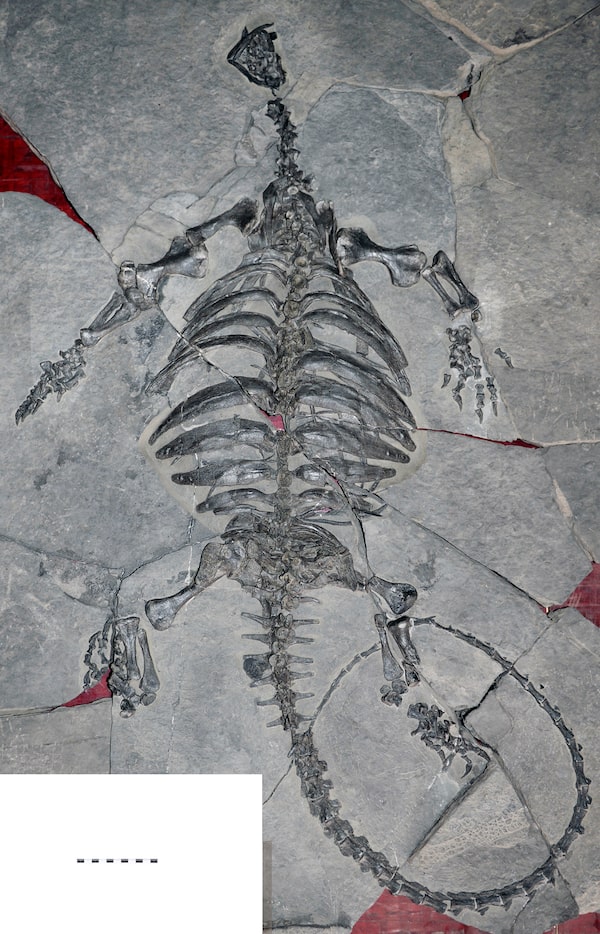
An artist's impression of what Eorhynchochelys might have looked like as it foraged for food in shallow water during the later Triassic period.Yu Chen/Canadian Museum of Nature
By any measure, the turtle ranks among evolution’s most unusual experiments. Its signature adaptation, a hard shell made of fused and highly modified rib bones, sets it apart from all other vertebrates and has long challenged scientists’ efforts to understand how turtles first came about and where, precisely, they belong on the reptile family tree.
Now, a fossil uncovered in China has revealed a key step in the turtle saga.
Saddled with the rather unwieldy scientific name of Eorhynchochelys sinensis (which combines the Greek words for “dawn,” “beak” and “turtle”), the 2.5-metre-long creature is the earliest known to bear many of the features of that distinguish turtles today, even though it lacks a shell.
Based on several clues, the creature likely spent much of its time in water, perhaps in a coastal environment where it could have used its strong forelimbs and beak-like jaws to dig in the mud for food.
“It probably ate whatever it could get,” said Xiao-chun Wu, a paleontologist with the Canadian Museum of Nature who was part of the international team that examined the fossil. The team’s findings were published Wednesday in the journal Nature.
The specimen was initially discovered by farmers working at a rich fossil site in Guizhou Province, and was marked for further investigation by Dr. Wu’s co-author, Chun Li, of the Institute of Vertebrate Paleontology and Paleoanthropology in Beijing.

The complete skeleton of Eorhynchochelys was discovered in Guizhou Province, China.Xiao-chun Wu/Canadian Museum of Nature
Dr. Wu’s first glimpse of the fossil came last year during a trip to China, when much of it was still encased in rock. Yet its potential significance was already clear, he said.
Despite lacking a shell, the creature’s wide, flat ribs are a giveaway that it is somehow part of the line of reptiles that later evolved into turtles. Once the head was revealed, the creature was discovered to possess features that place it within a broad group of reptiles that includes dinosaurs, lizards, crocodiles and the ancestors of modern birds. However, Dr. Wu and his colleague place it on an evolutionary line that branched away from the rest at an early stage, leading to progressively more turtle-like forms.
The specimen was found in a layer of rock that dates back to about 228 million years ago, corresponding to the late Triassic period, a time when the supercontinent known as Pangea was beginning to break up and dinosaurs were not yet the towering giants they were later to become.
Eorhynchochelys is sandwiched between two previous discoveries from earlier and later time geological periods. The older one, from 240 million years ago, is a squat lizard-like animal. The one that came later, which Dr. Wu helped to discover, lived about 220 million years ago and sported the bottom half of a turtle shell, or plastron, but no top. Eorhynchochelys, which has fused hip bones and wide ribs but no shell at all, seems to provide a link between them.
Yet there are wrinkles. The mouth of Eorhynchochelys, with its prominent beak and shortened trunk, looks more turtle-like in some ways than the specimen that came later.
Dr. Wu argues that this shows that turtle evolution was not a straight road but a meandering path during which various traits were acquired, lost and acquired again until the defining features common to all modern turtles were locked in about 210 million years ago.
Robert Reisz, a paleontologist at the University of Toronto who was not involved in the find, doesn’t dispute this idea but said that the specific way in which the new turtle ancestor relates to previous finds is open to debate.
“The evolution of turtles remains a complex issue,” Dr. Reisz said. “They really went off the normal path in terms of their anatomy and did a number of things that are really strange.”
 Ivan Semeniuk
Ivan Semeniuk